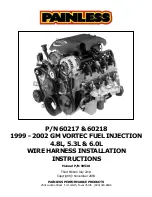
4
98
NOTE:
Use brass inlet needle for fuel pump
carburetors. Use aluminum inlet needle for
gravity feed carburetors.
Fig. 90
18
The fuel inlet seat orifice size and inlet needle are
different, depending upon the type of fuel delivery
system used. The carburetor bodies and inlet
needles are not interchangeable.
A color code on the side of the carburetor (19) is used
to identify the carburetor by engine model and fuel
delivery system,
Fig. 91
.
NOTE:
See the “Fuel System Identification Table” in
the Appendix for information.
Fig. 91
ÒÒ
ÒÒ
ÒÒ
19
Set Float Height
The float height setting on Nikki carburetors
depends upon whether the engine uses a fuel pump
(illustration
A
) or gravity feed fuel delivery system
(illustration
B
),
Fig. 92
. The procedure for checking
the float height setting is unique to each carburetor.
1. Hold the carburetor in one hand and place the
index finger on the float hinge pin (20).
2. While holding the float hinge pin down, turn the
carburetor to a position PAST
VERTICAL (21)
as shown in
Fig. 92
. This allows the weight of the
float to close the inlet needle.
3. The float height is the dimension between the
top flat area of the float just before the radius (23)
and the machined surface of the carburetor (22).
a. Float height for fuel pump carburetors (A) is
1/16” (1.6 mm) BELOW
machined surface
(22).
b. Float height for gravity feed carburetors (B)
is
3/32” (2.4 mm)
ABOVE
machined
surface (22).
ÒÒ
ÒÒ
ÒÒ
Fig. 92
21 – Vertical Line
22 – Machined Surface of Carburetor
23 – Top of Float (Before Radius)
A
B
20
21
22
23
20
22
23
To adjust float level, hold float arm at (26) with needle
nose pliers,
Fig. 93
. Carefully bend tang CLOCK-
WISE (25) to raise the float level, COUNTER-
CLOCKWISE (28) to lower the float level. DO NOT
collapse hooked end of float tang (27).
Fig. 93
25
26
27
28
4. Place new gasket (31) on lower carburetor body
(32). Make sure holes in body line up with holes
in gasket,
Fig. 94
.
5. Install upper carburetor body (30). Tighten
screws (29) securely.
















































